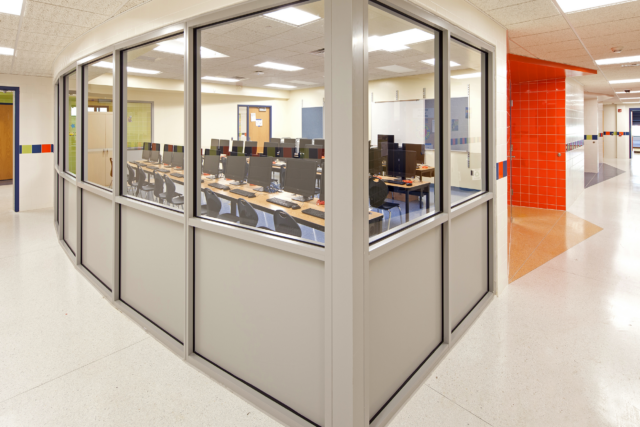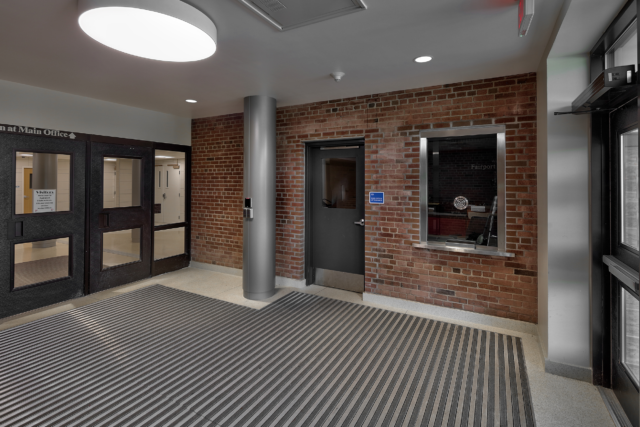Capital Project Planning for Safer School Environments

Security Master Planning is about more than adding cameras and locking hardware. It’s a collaborative process that considers threats from terrorism to natural disasters, and develops a balanced, holistic plan to mitigate the risk.
As architects and designers of K-12 schools, LaBella is often asked to address at least some aspect of security within school capital improvement projects. Such requests have become more prevalent in recent years as school security has become a national focus. School districts are attempting to improve the safety of their facilities in an effective and meaningful way; however, many are approaching the process of security enhancement without undertaking the larger task of security master planning. Further, it is often not entirely understood that the “…idea is not that design can definitively protect people from an active shooter or other hazard, but rather that it can discourage such threats or create delays that save lives.”1 Prior to engaging in any security capital improvements, and by extension, investment of tax-payer dollars, school districts must begin to approach the topic of security in a holistic manner.
Security master planning is a complex process that involves much more than designing building upgrades and alterations; it is a collaborative process between school district administration, design professionals, emergency response personnel and the public. Generally, this collaboration is founded on identifying threats and vulnerabilities in order to determine the most appropriate methods of protecting people, buildings and other assets. The planning process needs to take place well in advance of any project as “…security elements can be more economically integrated within structures during the early planning and design phases of new construction projects than during subsequent additions or renovations.”2
In general, the planning process for schools is intended to help a school district mitigate damage from four primary threats: terrorism, crime, workplace violence, and natural disaster. Depending on the local environment surrounding a school or district, there may be a need to focus more specifically on one threat over another. Identifying such priorities requires district administration to work with local authorities and their architect in an open, collaborative way. This collaboration also helps to establish a trusting relationship between those parties, which is essential to any successful project.
Conceptually, local authorities will help inform the planning process by offering lessons learned from past events, the architect will guide the process of integrating design and technology, and district administration will offer perspectives on operations. Together, the planning team should aim to provide a comprehensive security plan for the district that addresses the aforementioned topics in a transparent way to building users and the public. Public review and comment is always encouraged as part of the transparency of the planning process. Public concerns, whether well-researched or not, are always valid areas of the planning discussion and should be taken into consideration.
The planning and design process should be undertaken with a concept of balance in mind; the majority of school environments benefit from a balance of safety, function, and aesthetics. As a team of experienced architects, designers, and engineers, LaBella is well-versed in the process of addressing security planning in a balanced manner, effectively accounting for future growth, physical characteristics of environments, and design and functional elements of buildings. Too much emphasis on one consideration can leave behind important aspects of another.
For example, exterior perimeter fencing is a common element in site security planning. Fencing can be an effective barrier that helps prevent criminal activity; however, in a “…free and democratic society, security must be achieved without resorting to a bunker mentality.”3 There is a balance to be had between erecting a 10-foot chain-link security fence and one that is lower, with more aesthetic appeal. The taller fencing is more difficult to scale and overcome, but presents an austere image of the school to the surrounding neighborhood and community. The shorter fence is easier to overcome, but offers a balance of security and aesthetics that may be a more appropriate image for a community school. Such considerations should to be vetted through the planning process to the point where the district is confident and justified in the approval of all capital improvements.
Technology plays an important role in the security planning process. LaBella is often tasked with designing security systems, closed-circuit television systems, door access control devices, and other “active” technologies as part of capital improvement projects. Additionally, there are a myriad of new building products and systems that offer various degrees of security enhancement; however, the planning process should treat such elements with a balanced approach as well.
Active systems, or those that typically require electrical connections and consistent monitoring, are of great benefit, but add cost to a project. Security cameras, public address systems, and panic/active-shooter buttons represent some of the most common active systems available. Their implementation should be carefully considered and their locations strategically identified to maximize effect and balance cost. An over-emphasis and reliance on applied, active technologies can leave behind other important considerations of the physical environment that need to be addressed, including proper site planning, building plan layout, interior environment and school operations, and emergency protocols.
Passive systems, or those that do not require electrical connection, include everything from the physical school environment (walls, roof, etc.) to window film, signage, and first aid kits. The majority of security enhancements are passive systems, and in many cases can easily be incorporated within the design of building renovation projects, if identified early in the planning process. Regardless of passive or active system selection, the evaluation requirements for existing environments remains constant; identifying the type of threat is the primary objective, which allows for an accurate determination of preventative measures to be taken.
Working closely with design professionals will ensure a collaborative process by which threats can be identified and properly designed for. A security master planning process will ensure accurate threat determination and provide thorough facility evaluation, identification of facility vulnerabilities, and proper security upgrade recommendations.4 LaBella consistently works with district officials to help them navigate the complex security planning process. We encourage all school districts to establish a collaborative team of professionals to engage in the security master planning process prior to the designation of any scope of work or establishment of any capital improvement project budget.
Citations
1. Kirk, Mimi. “How Architecture and Design Can Hinder Active Shooters,” Architect, September 2018, pp 79.
2. Nadel, Barbara. Building Security, McGraw-Hill, New York. 2004. pp 2.2.
3. Nadel, pp 2.2
4. Nadel, pp 2.3

